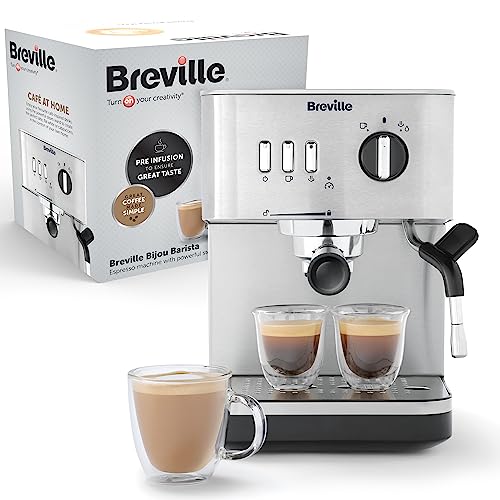How to Make Espresso Machine Coffee
An espresso machine can produce an excellent cup of coffee, but it requires some more installation and maintenance than a standard drip coffee maker. It also requires you to grind and tap your own beans.
The secret to making espresso is pressure. Here's how an espresso machine operates: a heater is used to heat water to a suitable temperature before forcing it through the grounds before pouring out the spouts.
Temperature
Espresso is produced by forcing hot water through finely ground coffee. The temperature of the water is critical to the quality of the final shot. Insufficient temperatures can result in the an under extraction of essential flavor compounds. High temperatures can lead to over extraction, which can cause bitter or burned taste.
The ideal temperature range for espresso is 195 to 205 degrees F. This temperature is achieved using a group head made to maintain the same temperature and stability throughout the brewing cycle. The E61 is the most popular group head as it comes with the ability to stabilize temperature, pre-infusion and lever control.
When altering the espresso machine for different roasts and brew ratios it is important to consider the effect of temperature on the extraction yield and crema. The ideal temperature will differ according to the bean and roast. However the general rule is that lighter roasts with higher brew rates require higher temperatures. A high-quality thermocouple is crucial to keep the temperature at a constant level.
Pressure
In the process of brewing, espresso machine coffee is pushed through finely ground and tamped grounds. This triggers chemical reactions that extract flavors oils, flavors and other soluble components from the beans. www.coffeee.uk resulting drink is usually more flavorful and richer than regular coffee.

The ideal espresso machine pressure is nine bars of pressure which is equal to the atmospheric pressure at sea level. The soluble compounds present in the espresso bean are best extracted at this pressure.
However certain espresso machines advertise 15 or even 20 bars of pressure. Although these machines can attain these levels of pressure however, they might not be able to maintain the same pressure throughout the extraction.
To put that in perspective For a better understanding, one bar is equivalent to the 32 pounds per square inch PSI of a car tire. It's also more than four times the pressure that professional cyclists use when filling their bike tires. The ability to control the espresso machine's pressure and make consistent espressos is key for any serious barista at home.
Water
Water is a key ingredient in a good cup of espresso. The right water allows your beans reach their maximum potential. However the wrong type of water could cause problems such as clogged pipes and even damage your expensive machine.
The best option is natural spring water that is rich in minerals for optimal espresso extraction. This water will elevate the flavor of your espresso without the chalky mineral trace that comes from tap or bottled water. This is a great alternative to distilled or reverse osmosis water, which may be too pure and cause problems with flavor.
You should not utilize a water filtration device that removes excessive amounts of mineral content from the water you drink. This can lead to flavor and extraction problems. A great option is to buy a water test kit which will provide you with the water hardness in your area. This information can be used in determining the correct filtration system to your espresso machine.
Beans
The majority of coffee enthusiasts become enthralled in the whole process of making espresso. They obsess about a number factors, such as temperature, water pressure, and viscosity. If one variable is not working, even a little, the entire shot could taste bad.
The beans used are the most important aspect when it comes to espresso. Many believe that only certain kinds are suitable for espresso. Although certain beans are suitable for certain uses however, any coffee bean that has been roasted can be used to make espresso. The main difference between espresso beans and regular coffee beans is that espresso beans are roasted for longer in tipycally, well past the second crack and give them more of a dark appearance and makes them more soluble in water.
The best espresso beans tend to be medium or dark roasted, which give the shots that distinctive richness and vigor. Light roasted beans can also be used to create great espresso, particularly if they are pre-ground for convenience in an espresso maker.
Milk
Espresso and milk are a classic combination. The coffee doesn't just increase energy levels, but the steamed milk helps to offset the bitterness of the espresso and provides a delicious creaminess. There aren't many culinary pairings better than this one!
If you choose to buy an espresso machine that can also make cappuccino or latte make sure to consider how easy it is to use. A lot of the top machines come with a jug for hot or cold milk, as well as steam wand. They also have an espresso portafilter that can be used to make the shot. Some models also have a built-in grinder along with a tamper, frother and tamper.
The steam wand must be purged before using it for the first time throughout the day (or after every cup of espresso) to remove any water that has condensed. The process takes only 30 seconds, but is vital to keep your machine running smoothly. If you don't cleanse it, it could result in bitter taste and/or buildup of bacteria, which could alter the taste or odor of your beverage. It's simple to perform and should be a part of your regular maintenance routine.
